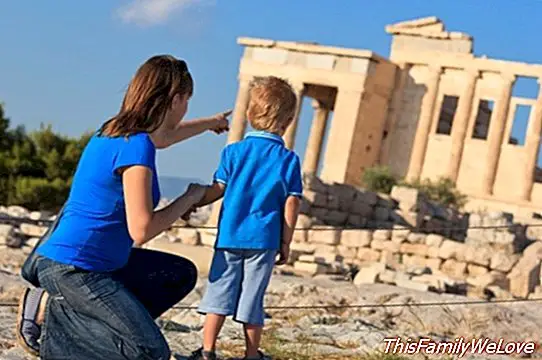8 excursions to discover Rome without leaving Spain

Taking a family outing is always a good plan. Now, discover Rome without leaving Spain is possible through eight excursions that make a tour of the peninsula in search of the traces of the Roman Empire. There was a time when Hispania was an important enclave for this empire. The centuries have passed but we still have magnificent monuments.
The best destinations for the family
The best destinations in Spain to visit with family the remains of the Roman Empire in the Peninsula:
1. Hippolytus House (Alcalá de Henares, Madrid)
Located in Alcalá de Henares, young patricians came to this place to train in arts and militias. The name of this building is due to the master craftsman who designed the beautiful mosaic that covers the patio and that represents a fishing scene.
More information: City Hall Alcalá de Henares: www.ayto-alcaladehenares.es
2. Mérida (Badajoz, Extremadura)
In this city there are so many Roman monuments that we can find that it is difficult to highlight one above the others. It is very interesting to visit the Theater, the Temple of Diana, the Aqueduct of Miracles, the Amphitheater, the Arch Trajan, the Cornalvo Dam, the Casa del Mitreo and the bridge that crosses the river. The neighboring Cáceres is not far behind and offers the Puente de Alcántara and the Termas and the Forum of Caparra
More information: City of Mérida: www.merida.es
City Council of Cáceres: www.ayto-caceres.es
3. Arch of Triumph of Medinacelli (Soria)
This monument is the only example of monumental arch of three spans that we have in Spain, which is strange if we take into account that they were the arches that were most built within the Roman world. Its conservation status is good, although the ornaments it has been lost due to its location, exposed to wind, rain and snow. In Soria We can also visit the remains of the Celtiberian-Roman city of Numancia.
More information: Tourist Board of Soria: www.sorianitelaimaginas.com
4. Tower of Hercules (La Coruña)
This tower was built by the Romans as navigation headlight in the 1st century AD It is the only Roman lighthouse and the oldest functioning in the world and has several legends to its surroundings; one of them tells that it is built on the place where Hercules He buried the head of the giant Geryon.
More information: Turgalicia: www.turgalicia.es
5. Theater and Walls of Zaragoza
Founded by César Augusto, the city of Zaragoza is surrounded by Roman walls of the 1st century. The theater became one of the most sumptuous of Roman Hispania, with a capacity for 6,000 people. In the third century began its decline, as part of the stones that comprise it were used to build other buildings, staying in the state that we can contemplate today. The Public Hot Springs Romans are also worth a visit.
More information: Zaragoza Tourism Office: www.zaragoza.es/turismo
6. Temple of Claudio Marcelo (Córdoba)
It was not the only Roman temple that there was in Cordova, but one of the most important. Currently, the only remaining remains of the building are its foundation, the staircase, the altar and some shafts of columns and capitals, and they are the result of a reconstruction project. The researchers identify the temple as part of the ensemble dedicated to the imperial cult, that is, to the Roman emperors deified
More information: Provincial Tourist Board of Cordoba: www.cordobaturismo.es
7. Aqueduct of Segovia
This spectacular monument It is one of the most significant and best preserved left by the Romans in the Iberian Peninsula. It is not surprising that for this reason it is the most important symbol for the inhabitants of Segovia and that appears on the city's coat of arms. The aqueduct leads the waters of the spring of the Fuenfría to the city, traveling more than 15 kilometers.
More information: Tourism Office of the Junta de Castilla y León: www.turismocastillayleon.com
8. Amphitheater of Tarragona
Built in the 2nd century d. C. on the shores of the Mediterranean Sea, in the amphitheater they had different place popular shows, like the fights between gladiators. It has the characteristic elliptical floor of this type of construction. Under the sand, stage of the shows, there are some pits that served as ancillary services.
More information: Tourist Board of Tarragona: www.tarragonaturisme.cat/en
Conchita Requero




